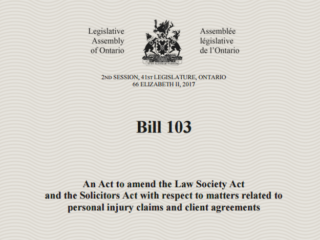*Edited by Tom Connolly
In dismissing a motion for a mistrial based on the jury conducting internet research, the court held that mistrials should be granted only as a last resort and the corrective charge was sufficient to ensure a fair trial.
Date Heard: April 20, 2018 | Full Decision [PDF]
After eight weeks of trial, wherein liability was hotly contested, the jury began five days of deliberation on a Friday. Over the weekend, juror #1 engaged in internet legal research at his home. He found the Fault Determination Rules regulation under the Insurance Act. On Monday morning, juror #1 discussed the Regulation with the other jurors. The jury after over two hours of discussion sent questions to the judge. This first question asked about a so-called part of the Highway Traffic Act as follows:
In the highway traffic act there is a part which states “It is illegal to park on a roadway outside a city town or village”. It also says if a vehicle is struck while illegally parked, then the parked vehicle is 100% at fault. The jury is wondering if this park of the traffick (sic) act should be considered.
The Plaintiffs moved to strike the jury for breach of their oath to decide the case only on the evidence presented in the Courtroom and not on the basis of law discovered by a Google search. The Plaintiffs alleged that the jury was tainted, having been exposed to extrinsic prejudicial information.
Justice Hackland dismissed the Motion to strike the jury and decided to make a corrective charge which directed the jury that the Fault Determination Regulation was irrelevant, that they were to disabuse their minds of the Regulation and refrain from any further research. The jury eventually found the plaintiff 73% contributorily negligent and the defendant 27% at fault. The Plaintiffs sought an order declaring a mistrial due to the alleged contamination of the jury by the internet research and their alleged failure to abide by the court’s correcting charge by recording a reason for the liability split as “illegal parking”, which words only come from the Fault Determination Regulation.
Justice Hackland noted that a mistrial will be ordered only “as a last resort, in the clearest of cases and where no remedy short of that relief will adequately redress the actual harm occasioned” (para 24, quoting R. v. Jeanvenne, 2010 ONCA 706). The issue before the court was whether the correcting charge was sufficient in the circumstances and whether there was “any cogent reason to believe that the jury declined to follow it” (para 29).
In dismissing the motion for a mistrial, Justice Hackland held:
As noted previously (para. 21), the jury specified, as one of the particulars of the plaintiff Mr. Patterson’s negligence, “in violation of section 170, subsection (12) of HTA illegally parked on roadway impeding with (sic) flow of traffic”. The jury should be taken at its word that they were in fact referencing section 170, subsection 12 of the Highway Traffic Act. That provision (quoted previously in para. 9) was drawn to the jury’s attention in the jury charge and deals with parking a vehicle on a roadway and impeding traffic. While subsection (12) of s. 170 of the Highway Traffic Act does not contain the word “illegal”, illegal is a term of general usage connoting a contravention or violation of the law and is not a concept specific to the Fault Determination Rules.
Furthermore, if the jury had applied the Fault Determination Rules based on the plaintiff being illegally parked, the regulation would have required the plaintiff to be found “100 per cent at fault” and the defendant “not at fault for the incident”. Instead the jury apportioned fault on a 73% / 27% basis against the plaintiff. This is a fault apportionment amply justified by the evidence presented in this case. In arriving at this apportionment, the jury also specified other particulars of fault, separate from and in addition to parking on the highway. (Paras 32-33)
Justice Hackland held that the evidence demonstrated that the jury respected the corrective charge and avoided any further consideration of the Fault Determination Rules.
Read the full decision [PDF]












